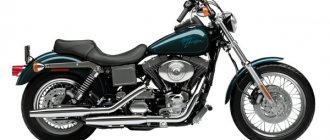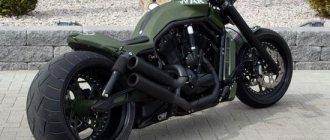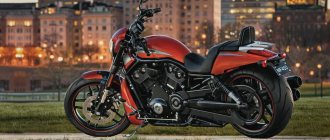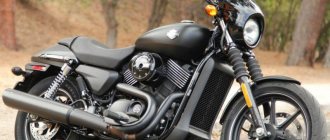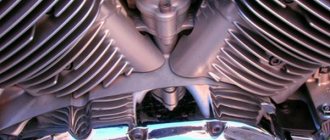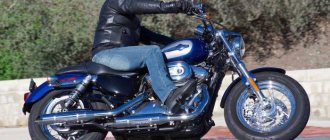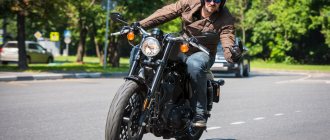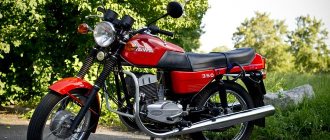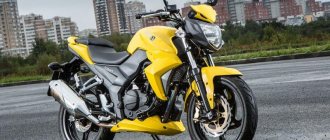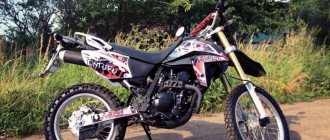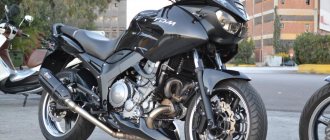Technical characteristics of Harley Davidson Dyna Glide
| Engine volume, cm3 | 1584 |
| Power, hp | 78 |
| Number of cylinders | 2 |
| Number of cycles | 4 |
| Maximum speed, km/h | 190 |
| Gasoline consumption, l | 5,6 |
| Tank volume, l | 19 |
| Transmission | 6-speed |
| Seat height, mm | 710 |
| Weight, kg | 300 |
The Twin Cam's powerful V-twin engine has two cylinders. An air cooling system is used. Ignition is electronic. An electric starter is used to start the engine. There is no ignition switch as such. Its role is played by a toggle switch. At low speeds the engine has a flexible character. If you set the speed above average, the acceleration dynamics are impressive.
The belt drive is reliable and durable. It transfers power to the rear wheel very well. The suspension has proven itself well in conditions of perfectly smooth asphalt, so it is not recommended to get into holes often enough. The front fork is telescopic with a tilt angle of 29°. The rear suspension is a pendulum with two shock absorbers. The rear suspension travel is only 79 mm, which is clearly not enough for driving on our roads.
The Harley Davidson Dyna brake system surprises with its characteristics. It is significantly superior to many HD choppers. Disc brakes, hydraulic.
Test drive Harley-DavidsonDyna FLD Switchback
Harley-Davidson motorcycles should not be judged solely on ride performance. But for most motorcyclists, they, as well as the quality of the motorcycle, come first. Everything else, the charisma of the brand, the style and prestige of the model is just a pleasant addition. And ideally, everything should be at a high level.
In the case of Switchback, there is no need to talk about the style of the motorcycle and the prestige of the brand. It goes without saying that for many bikers, Harley-Davidson is a golden dream and an icon in the world of motorcycles. But each model from this manufacturer has its own personality, and the Switchback even more so. This is the second motorcycle in the company’s line, which allows you to easily transform it from a cruiser to a motorcycle for the city. The first was (and still is) the CVO Softail Convertible. But, since it belongs to a limited series of factory custom bikes, it costs more than one and a half times more.
Switchback is a production model, and therefore its price is more affordable. Although Ukrainian realities turn the $15,999 that they are asking for it in the States into 230,000 Ukrainian hryvnia, which will have to be paid for a new product in Ukraine. This, to put it mildly, is not small, and therefore you should ask the motorcycle “in full”.
Vladislav Sofonov
Height: 180 cm, weight: 75 kg.
Driving experience: 10 years.
I'll start with ergonomics. In terms of ease of landing, the Switchback is at the level of a good tourist. It can easily cover long distances. You don't just sit down, but sink into a low, soft, wide seat. The footrests are located moderately far away and you don’t have to reach for the steering wheel. I am sure that even shorter drivers will feel quite comfortable behind the wheel.
Now let's move on to the appearance. There really is nothing to complain about here. The quality of workmanship and finishing is beyond praise. Every detail you take has clearly been carefully analyzed in terms of how it will look on this bike. The “feature” of the model – quick-release saddlebags and windshield – have also been carefully adjusted.
By the way, these panniers have a smaller volume than those installed on large HD tourers. But this is already a tribute to style, which comes first in Switchback. The simplicity and ease of “undressing” the motorcycle is truly commendable. Of course, I can unfasten the side panniers on my motorcycle in a matter of seconds, but the aesthetic factor is also important here, because the fastening elements of the panniers on the Switchback are hidden from prying eyes, which cannot be said about most motorcycles of other brands.
But the quick-release fastening of the windshield seemed to me not reliable enough, because two ornate springs made of round steel wire act as latches. Although, we must give them their due - the glass does not sway or jump out of the grooves even on our bumpy roads. On the other hand, I would give this solution 5 points for practicality. After all, on a hot summer day it is much more pleasant to drive around the city without a windshield, feeling the cooling flow of the wind. In addition, without panniers and a windshield, the motorcycle becomes visually lighter and somewhat narrower, and therefore it will be much easier to navigate city traffic jams during rush hours.
The handling of the motorcycle is excellent. It easily maintains a given angle and trajectory when cornering. It is extremely easy to control even at very low speeds - the Switchback does not tend to fall towards the turn (thanks to the correct steering column geometry!). Its curb weight, which reaches 420 kg (with driver), is practically not felt.
But everything looks so good only when driving on smooth asphalt. As soon as you move from this to “real Ukrainian asphalt”, disappointment sets in. The front fender, made of a thick sheet of selected American steel, is a thing that deserves respect. But this is also a couple of kilograms of excess weight! Therefore, it is quite reasonable that I felt the front wheel bouncing even on very small bumps, the fork clicking during the rebound stroke, and on the ridge I completely lost the feeling of the road. The rear suspension seemed to me more knocked down, and besides, it coped well with unevenness, although it still lacks 3 centimeters of shock absorber travel to be ideal.
I wasn't impressed with the braking system either. For such a heavy motorcycle, one front 300 mm disc, even with a four-piston caliper, is not just not enough, but extremely small. In addition, the force on the handle is excessively high, which altogether leads to the need to use the rear brake, although when trying to stop sharply from a decent speed, it does not help. In addition, on this bike it is also not very informative. Perhaps, as we break in (and the motorcycle was completely new), the situation will improve somewhat, but I don’t think it will dramatically.
One last thing we could praise about the Switchback is its engine. But it was impossible to fully evaluate it, because for some reason it was frankly “stupid” in the zone above average speed. Why did I say “it could be”? The American Internet resource motorcycle.com measured the power of the Switchback engine on a dyno, where it produced only 66 hp. at 5000 rpm and 110 Nm at 3250 rpm. In fact, these indicators manifested themselves in frankly weak traction (except for the narrow “middle” - there is traction there), which is not at all adequate to the engine size. Perhaps, for the sake of strict European economic standards, the “brains” were reconfigured, and the engine has not yet been run-in... Then the situation can be improved later by slightly “doing magic” with the software settings of the engine and making it easier to “breathe”.
By the way, the sound coming from the exhaust pipe is also a C grade. Perhaps it was also toned down at the factory, but they did it too radically. After the purchase, the owner of this bike will definitely install a tuning exhaust, and it will be right!
In the end, to summarize the above, I have to admit that the Harley-Davidson Switchback disappointed me. From such an eminent manufacturer, I expected to see a balanced model that would surpass its competitors in all respects. But that did not happen. The motorcycle captivates only with its original appearance, but it could not seriously impress me with its driving performance.
Andrey Blinov
Height: 183 cm, weight: 105 kg.
Driving experience: 14 years.
“Daina”... I associate this name more with an air rifle (although it is spelled differently), but oh well. This is still a motorcycle, and not just any kind - with a 103 cubic inch (1690 cm3) engine, as evidenced by the eloquent inscription on the gearbox cover. But I want to warn you right away: this engine does not have a balancing shaft, and is attached to the frame at three points, but only at two - through rubber pads...
When you start the engine, you understand how clearly you can demonstrate the expression “your heart jumps out of your chest”! But I won’t get ahead of myself.
An external inspection showed that the Switchback has a standard, “Harley” layout, but with marketing “tricks”: there are quick-release panniers and an even quicker windshield. The glass can really be removed quickly - literally in seconds, but... not only the owner can do this! In fact, anyone can get hold of a windshield from HD, both for their “Dnepr” and any other “chopperoid”... But with panniers, such a number will not work. Both of them also unfasten in a couple of minutes, but only if their lids are open, and this process is not so simple, I tell you - a whole shamanic dance with a tambourine. Although, having performed this operation twice in a row, I am ready to admit that all the movements are simple and well thought out - even if you forget to lock the cases, their lids will not open while moving, no matter how much shaking! True, even in the locked position they slightly tap on uneven surfaces, so ideally they should still be compacted.
Belt drive, alloy wheels, but there is one front brake, but with ABS. The tidy is a “Kharitonov” classic: the light bulbs are located separately. But - lo and behold! Dyna now has a tachometer!!! True, the revolutions are displayed in ultra-small numbers on a small LCD display - it makes you want to attach a large magnifying glass over it! When using the “trip” button to scroll through the functions of the scoreboard, the tachometer does not turn on immediately! First, the display will show an animation of “stars”, then a creeping line and text in English will appear, which can be loosely translated as: “Attention! Now the engine speed will be shown!!!” If you take into account the height of the font (no more than 10 mm), and multiply the clarity of the image by the vibration-massage capabilities of the motor, then it can hardly be called informative.
What's in motion? Unfortunately, my first “contact” with this Duna turned out to be as a “butt buster”. This, I tell you, is a number! After 10-15 kilometers spent in the passenger seat, my tailbone was knocked off. Moreover, not with the suspension - there were no complaints about it, but somehow it served its time, or something. But pain began to appear even from engine vibration. I can’t say that this is a rule - with average suspension settings, and a load in the form of two “carcasses” with a total weight of 240 kg, perhaps this is the motorcycle’s response to bullying. But just in case, based on the results of our “extreme fitting”, choose passengers who are small, fragile, but with a wide and soft bottom - so as not to hear curses from them later. Better yet, order a customized passenger seat. By the way, you don’t have to spend money on a driver’s license – later I was completely satisfied with it.
The rear suspension managed a minus four (we did hit it a couple of times, but don’t forget about the soft settings of the shock absorbers). In general - a sufficient minimum. But it’s difficult to exactly call it comfortable... This is about the rear suspension. Sitting in the back, talking about the fork is useless. One of the jokes of the ergonomic design is that the passenger footrests are attached to the pendulum. And on uneven surfaces, the motorcycle “moves the legs” of the passenger. The amplitude is not strong, but there is a chance of scratching something shiny with boots (or heels) walking up and down. And finally, from the passenger’s impressions: be sure to use the backrest! The motorcycle is a little “nervous”, and without it there is a chance of simply losing a passenger.
While driving, the situation changed. The rush is over, the footage has been captured, and I have a few hours of one-on-one time ahead with the Dyna Switchback. The fit is generally quite adequate. It may be unusual for the average motorcyclist, but it is logical. At least, it cannot be called uncomfortable, rather, on the contrary. The remotes are a little inconvenient in small things. Unusual for the “Japanese driver” will be the buttons for turning on the turn signals (one on each side) and on the left this very button is located exactly in the place where the signal is located on other motorcycles... And it is a small double button above the left turn signal button. But you get used to it quickly. The signal itself, by the way, is pneumatic and very loud, one thing is upsetting - while the compressor is spinning up, there may be a reason to signal the abyss. In other words, the signal sounds like a steamship whistle, but also “slows down” a little.
Visibility in the mirrors is surprisingly quite good, and they even have an anti-glare layer applied to them. However, I would be very happy to spread this same layer over all the chrome. Everything glares in the sun, and “sunbeams” periodically hit your eyes. The steering wheel is high, but in moderation, and there is “something” about it.
The panniers have a small volume, but do not interfere at all when driving between the rows. Lids, as I already said, are a “shamanic dance with a tambourine.” We open the lock, unlatch the locking mechanism, pull the outer side up, recess the lid to the wing and move it to the inside of the case, and then “flip” the lid out... Everything would be fine, but the cases are double-layered (optional thermos?!), and there’s something in the pits in them It rumbles so disgustingly. Either the lids or the “layers”, but there is a feeling of a “32” open-end wrench forgotten inside...
The glass, despite its completely unsightly dimensions, copes with the task “excellently”; I did not even expect it. There was nowhere to accelerate Daina “with all the money”, but at 140 km/h the oncoming wind did not cause me any discomfort at all. It's a rare case that standard glass works so well.
Among the conveniences and usefulness: a fuel gauge (pointer), in the false tank lid (on the left), as well as an immobilizer and alarm system, as they say, “in one bottle.” I still didn’t realize how the immobilizer worked - it was either recognized 7-10 meters from the motorcycle, then it didn’t work until I brought the key fob into the “meter zone”. To avoid sadness, when stopping, you should not forget about locking the ignition switch and steering wheel - this is not a cheap toy.
Everything vibrates at idle!!! Steering wheel, mirrors, footrests...
Vibrations (but with a different frequency) also appear under load, in the region of 3500-4000 rpm. But I managed to drive from traffic light to traffic light without “shaking”... This means that you can get used to this and avoid them, or at least smooth them out, choosing a comfortable speed. But, standing at a traffic light, at least turn off the engine. A boy of about three years old pointed his finger at me and said something to his dad. Of course, I couldn’t hear it, but it’s not difficult to guess: “...Dad, look, uncle is about to lose his engine!”
It’s very hard to believe that this is how it was intended, but fans of the brand value precisely these engines of the Evolution series, calling them “alive.”
Literally one word about the exhaust – it’s nonsense. Apparently the manufacturer, realizing that after purchase it was immediately replaced with a tuning one, decided to save money - what difference does it make that the client later sends it to a landfill! But the characteristic sound of a “Harley” with a standard pipe is not recognizable at all.
The suspension is completely strange - the fork behaves great at low speeds, but at high speeds it turns into two sticks, transferring everything to the steering wheel and footpegs. A couple of times my legs almost jumped off the hefty platforms. During rebound the fork makes a clicking noise, which surprised me. In general, passing at a good speed, for example, the connecting seam of a bridge, has a very negative effect on comfort. No, due to its mass, the motorcycle perfectly maintains its trajectory, but it somehow gets shaken up. But the handling, especially at low speeds, is simply excellent. You can maneuver in traffic jams and between rows with ease and ease. And if we add to this a stable ride in 1st or 2nd gear with the throttle fully closed, we get a “city tourer”.
In general, “Daina” played a trick on me. While I was riding it, I was drawing a plan for the article in my head, but in the end it turned out that everything was completely wrong. Almost all the problems went away, as they were related to the absolute novelty of the specimen. By the end of the test, the brakes got used to it a little and appeared, the gearbox stopped being so tight, the clutch gained feedback, and the “neutral” began to “catch” the first time.
The entire Harley-Davidson brand is a unique philosophy and a great marketing achievement. The motorcycle is beautiful, moderately comfortable, and quite interesting. But for some reason, it seems that for its price it should only bring pleasure, surround you with care and attention, but we get exclusively “philosophy” and a bonus when, to the classic question of the average person: “Is this Harley?”, you can boldly and proudly answer “Yes” , THIS IS A Harley-Davidson!”
Valery Chuikov
Height: 186 cm, weight: 125 kg.
Driving experience: 30 years.
I turned out to be the only participant in the “fitting” who had previously managed to ride quite a lot in various models of “evolutions” with air engines of different sizes, and the only one who had to carry a passenger of considerable size all the time. The motorcycle was completely new, and this certainly left its negative imprint. The brakes did not slow down, the gearbox worked tightly and harshly, and the engine did not develop the usual “pulling” traction. But, as Andrey noted, by the end of the test everything had improved and most of the negative aspects “ran away” along with the kilometers, although some remained and will never go away on their own. I will focus on them. The first is the brakes. One disc at the front is clearly not enough for a motorcycle with such a gross weight, and the force required to activate the ABS on dry asphalt can only be developed by a bodybuilder. A possible solution is to replace brake machines with a different ratio of piston diameters. The second is the exhaust sound. During the Electra Glide test of 2010, I clearly remember that thrilling feeling during my first acquaintance with the “evolution” engine, which I experienced every time I unscrewed the throttle of the “96” Twincam that was on it! Here there was only a pathetic muttering, which can only be gotten rid of surgically - by replacing the stock “2 in 1” exhaust with “correct pipes”, for example, from Vince & Hince. Third is the pendants. There are no special complaints about the rear - the standard shock absorbers handle small and medium-sized irregularities quite well, but due to the small stroke (only 54 mm) they give in to more or less deep (3-5 cm) holes and swelling, which, unfortunately, are present on ours. Most of the roads are imperfect. In addition, other than preloading the spring, no other changes can be made to their operation. Therefore, specifically for Ukraine, the treatment looks clear: replacing and only replacing them with tuning ones, for example, from Ohlins, will save the situation. With a better fork - its travel is sufficient at a moderate pace of movement and everything would be fine if not for the nasty “clack” at the end of its rebound travel. As they say, it doesn’t affect the result, but it leaves a residue. I think that the defect will be partially (and perhaps completely) cured by selecting oil with a different viscosity. And the last thing is the strange nature of the engine. It works great and carries two “gorillas” in first and second gears with the throttle fully closed, but for some reason it “shuts up” a little at “above average” speeds, from 3500 and above, giving its riders nasty small vibrations. I assume (and hope) that this is a certain operating mode of the ECU for the break-in period, which will be changed to normal at the first maintenance.
Now about the pleasant things. The driving position, wind protection to the torso and head, and overall handling and stability at walking speeds (even with a heavy passenger) are simply excellent. I also liked the seat and the ability to quickly transform the motorcycle from a tourer to a city bike and vice versa.
Who is this new transformer from H.-D. for? I think that after an inexpensive customization, it will become a good alternative to those fans of the brand who dream of a Road King, but it is too big, heavy or expensive for them.
Photo: Andrey Shlenchak
Disadvantages of the model
- There is no tachometer, but this is common to all Harleys.
- A slight turn of the steering wheel makes turns more difficult.
- Low-mounted running boards scrape along the asphalt even on slight inclines.
- Short travel rear suspension.
Overall, the Harley Davidson Dyna Super Glide is suitable for both city driving and country trails. Good handling and a reliable, powerful braking system make riding the bike quite safe. If desired, with the help of light tuning, the appearance of the bike can be changed beyond recognition.
Harley Davidson Low Rider
The series has been a commercial success since its introduction in 1977 as the FXS Low Rider, featuring alloy wheels, dual front brake discs and a low seat height of just 66 cm. The Low Rider was then transferred to the Dyna platform in 1993 and released as the FXDL. , having gained a new portion of people's love.
When the newest version of the Softail platform was introduced in 2021, the shocking news was that it had absorbed the Dyna platform, causing some panic among fans of the series' twin rear shock absorbers. The new Harley Davidson Low Rider, created on the Softail platform, was considered by fans of the brand to be an impostor, unworthy of attention. Aftermarket prices for the Dyna Low Rider S immediately went up, even though the new Softail-based Low Rider is an all-around better bike.
Tuning and repair
One of the reasons for the incredible popularity of this brand all over the world is the truly immense possibilities for tuning and simple repairs. Any Harley-Davidson is a construction set for adult men, in which everything can be replaced. Do you want a new engine with a capacity of about two and a half liters? Easily. New transmission? Please. Wheels, seats, fenders, body kit, gas tanks, carburetors and injectors... Absolutely everything in this motorcycle can be replaced if you have enough money. Moreover, in addition to the official tuning catalog, Dyna parts are also produced by dozens of other manufacturers.
Repairing the bike is also easy. The only peculiarity is the inch system. Models of recent years, officially sold by Russian dealers, are already equipped with metric bolts and nuts, but those copies imported here from the USA are still inch. In practice, this only means that you will have to acquire a set of American tools. But this doesn’t make it any more difficult to maintain or repair your favorite motorcycle.
